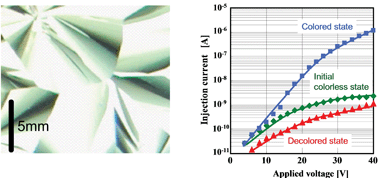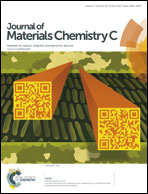Electrical characterization of photochromic diarylethene films consisting of extraordinarily large crystallites†
Abstract
Photochromic diarylethene crystal films are promising candidates for future organic memory applications but this has not yet been studied. We found that a specific molecule of photochromic diarylethenes (DAEs) formed a crystal film that consisted of extraordinary large crystallites with a 1 cm scale domain. We investigated the carrier injection/transport characteristics in the DAE crystal film and found that photocontrolled current switching using UV (λ = 365 nm) irradiation showed a large on–off ratio of 500, which was 50-times that of the amorphous film. Positive temperature dependence of the current was observed for the initial colorless crystal film, whereas negative dependence for the colored and decolored films was observed. The current level of the decolored sample was lower than that of the initial colorless state and the difference in the current levels was based on the change from the crystal to the amorphous state. The results are essential for achieving organic memory applications with DAE crystals.


 Please wait while we load your content...
Please wait while we load your content...